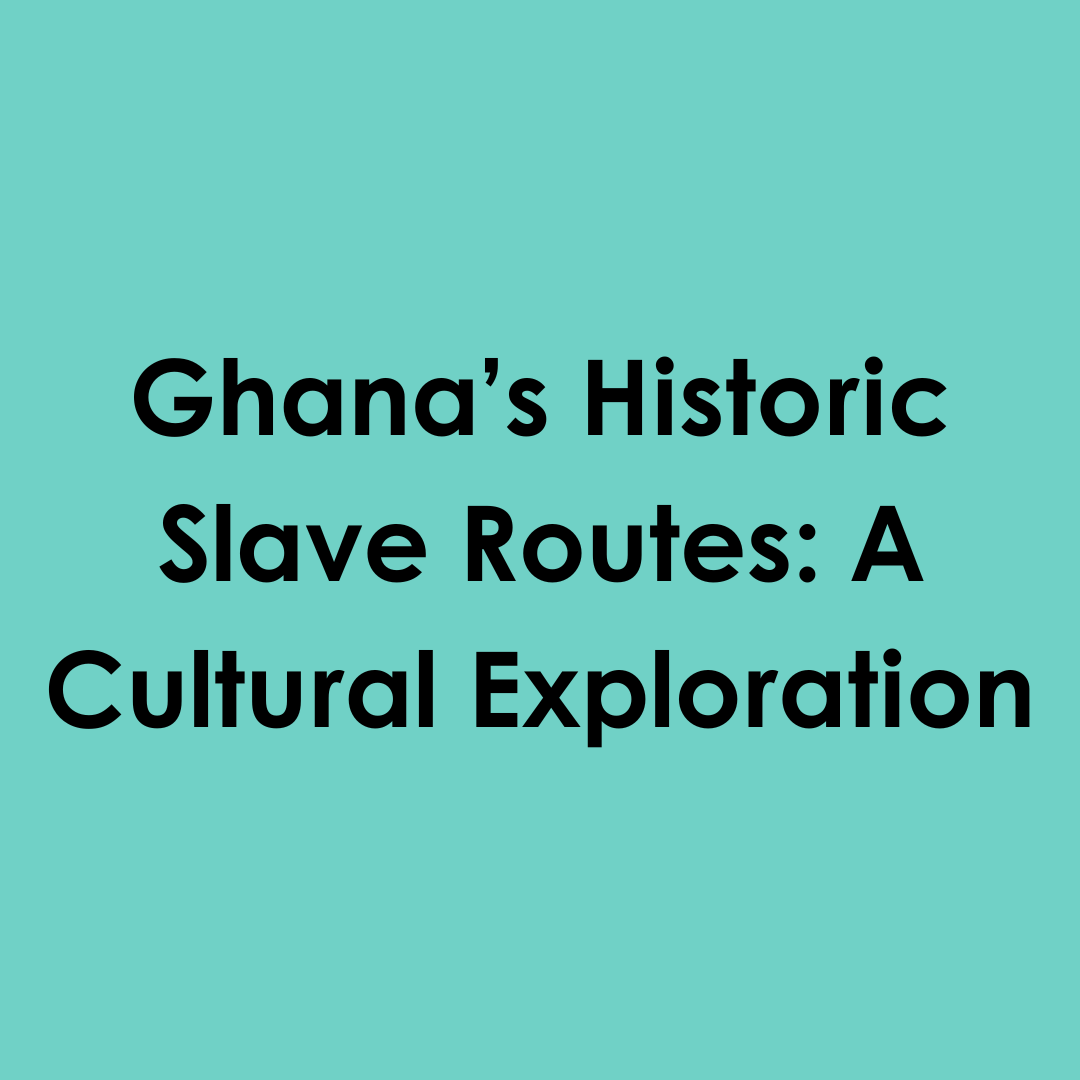Ghana, often referred to as the “Gateway to Africa,” holds a profound place in the history of the transatlantic slave trade. The country’s coastline is dotted with forts and castles that once served as the epicenters of the horrific trade that saw millions of Africans forcibly taken from their homeland. Exploring Ghana’s historic slave routes is not just a journey through physical landscapes but a deeply emotional and educational experience that uncovers the resilience, suffering, and strength of the African people.
This cultural exploration of Ghana’s historic slave routes delves into the history, significance, and enduring impact of the transatlantic slave trade, as well as the efforts to preserve and educate about this dark chapter in human history.
The Origins of the Slave Trade in Ghana
The transatlantic slave trade began in the 15th century, with the arrival of European explorers and traders on the West African coast. Initially, the interaction between Europeans and Africans was based on trade in gold, ivory, and other goods. However, as European colonies in the Americas grew, the demand for labor increased, leading to the establishment of the slave trade as a dominant economic activity.
Ghana, then known as the Gold Coast, became a central hub in this trade due to its strategic location and abundance of resources. European powers, including the Portuguese, Dutch, British, and Danes, built numerous forts and castles along the coast to facilitate the trade in enslaved Africans. These structures became the sites of immense human suffering, where Africans were captured, held, and eventually shipped across the Atlantic under inhumane conditions.
Key Sites Along Ghana’s Slave Routes
-
Cape Coast Castle: One of the most significant landmarks in Ghana’s history, Cape Coast Castle was originally built by the Swedes in 1653 and later expanded by the British. It served as one of the largest slave-holding sites on the West African coast. The dungeons, where enslaved Africans were kept in deplorable conditions before being shipped off to the Americas, are a stark reminder of the atrocities of the slave trade. Today, Cape Coast Castle is a UNESCO World Heritage Site and serves as a museum, offering tours that educate visitors about the horrors of the slave trade and the resilience of those who suffered.
-
Elmina Castle: Elmina Castle, built by the Portuguese in 1482, is the oldest European building in sub-Saharan Africa. It was initially a trade settlement but soon became one of the most notorious slave trading posts in the region. The castle’s dungeons held thousands of Africans, who endured unimaginable conditions as they awaited transport across the Atlantic. Elmina Castle also houses a museum that chronicles the history of the transatlantic slave trade and serves as a place for reflection and remembrance.
-
Fort Christiansborg (Osu Castle): Located in Accra, Fort Christiansborg, also known as Osu Castle, was built by the Danes in the 17th century. It played a significant role in the slave trade, with thousands of Africans passing through its gates. The castle has been repurposed multiple times throughout history, serving as the seat of the Ghanaian government post-independence. Today, it stands as a historical monument, with efforts underway to further preserve and open it to the public as a site of historical significance.
-
Assin Manso Slave River Site: Assin Manso, located inland from Cape Coast, was a key transit point on the slave routes. Enslaved Africans were marched from the interior of the continent to the coast, stopping at Assin Manso to be bathed in the “Slave River” and given a final rest before being taken to the coastal castles. The site now features a memorial garden and the “Last Bath” site, where visitors can reflect on the harrowing journey endured by countless Africans.
-
Anomabo Slave Market and Fort: Anomabo, once a bustling town on the coast, was an important center in the slave trade. The Anomabo Fort, built by the British in the 18th century, served as a holding facility for enslaved Africans. The town’s market square was also a site where slaves were bought and sold. Today, the fort stands as a reminder of the town’s dark past, with ongoing efforts to preserve it and educate future generations about its history.
The Cultural Impact of the Slave Trade on Ghana
The transatlantic slave trade had a profound and lasting impact on Ghanaian society. Entire communities were disrupted, with millions of people taken from their homes, leading to a significant loss of cultural, social, and economic capital. The demographic and social fabric of the region was forever altered, with ripple effects that continue to be felt to this day.
Despite this, Ghanaian culture has shown remarkable resilience. Traditional practices, languages, and beliefs have survived and even flourished, serving as a testament to the strength and endurance of the Ghanaian people. The descendants of those who were taken have played a crucial role in preserving and revitalizing their cultural heritage, both in Ghana and across the African diaspora.
Remembrance and Reconciliation
Ghana has made significant efforts to preserve its historic slave sites and educate the world about the transatlantic slave trade. These sites are not only important for historical education but also serve as places of remembrance and reconciliation. Every year, thousands of visitors from around the world, including many from the African diaspora, visit these sites to pay homage to their ancestors and reconnect with their heritage.
The Ghanaian government has also established initiatives such as the “Year of Return,” launched in 2019 to mark 400 years since the first recorded arrival of enslaved Africans in Virginia, USA. This initiative aimed to encourage people of African descent to visit Ghana, learn about their roots, and contribute to the country’s development. The “Year of Return” was followed by “Beyond the Return,” a decade-long initiative focusing on tourism, investment, and cultural exchange.
Challenges in Preserving Slave Route Heritage
While Ghana has made significant strides in preserving its historic slave sites, challenges remain. The effects of time, weather, and neglect have taken their toll on some structures, requiring ongoing restoration and conservation efforts. Additionally, balancing the educational and memorial aspects of these sites with the demands of tourism can be challenging.
There is also the need for continued dialogue about the legacy of the slave trade and its impact on contemporary society. Addressing these issues requires collaboration between the government, local communities, and international partners to ensure that these sites are preserved not only as historical monuments but also as spaces for reflection, learning, and healing. Exploring Ghana’s historic slave routes is a powerful and poignant journey into a chapter of history that has shaped the world we live in today. The forts, castles, and memorial sites along these routes offer a sobering reminder of the atrocities of the transatlantic slave trade and the resilience of the human spirit.
As Ghana continues to preserve and promote these sites, they serve not only as reminders of a painful past but also as symbols of hope, reconciliation, and the enduring strength of the African people. For those who visit, these sites provide a deeply meaningful experience that connects them to a history that is both profoundly tragic and incredibly resilient. Through education and remembrance, Ghana’s historic slave routes continue to play a crucial role in the ongoing dialogue about history, identity, and cultural heritage.
Journey Through History with Grassroot Tours
Grassroot Tours offers a deeply immersive experience exploring Ghana’s historic slave routes, taking you on a powerful journey through the heart of the transatlantic slave trade. Our tours provide a comprehensive and respectful exploration of key sites such as Cape Coast Castle, Elmina Castle, and the Assin Manso Slave River, where the echoes of history resonate through every stone and pathway.
Led by knowledgeable local guides, you will visit the dungeons were enslaved Africans were held, walk the paths they once trod, and stand at the “Door of No Return,” reflecting on the unimaginable suffering and resilience of those who passed through these harrowing spaces. Each stop is an opportunity to learn about the deep cultural and historical significance of these sites and to honor the memory of those who endured the brutalities of the slave trade.
Grassroot Tours ensures that this experience is both educational and emotionally impactful, providing visitors with a profound connection to Ghanaian history and the enduring legacy of the African diaspora. By choosing Grassroot Tours, you contribute to the preservation of these important heritage sites and support the local communities dedicated to keeping this history alive for future generations.



